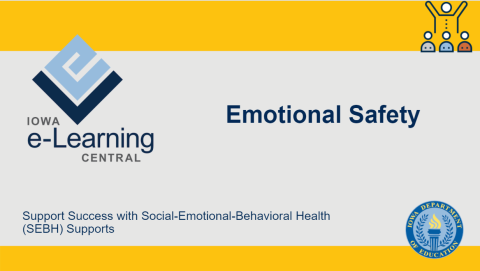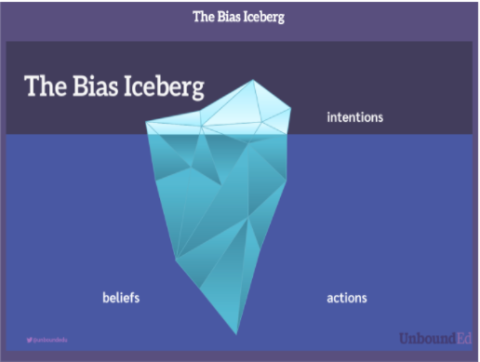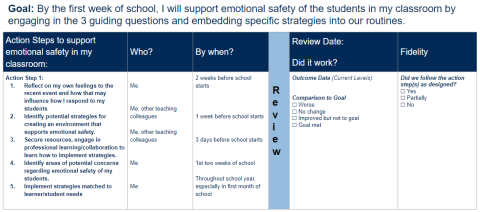
Click the link below for the
Emotional Safety module
The full version of the module is in the downloadable PDF above. An accessible text version is below.
Support Success with Social-Emotional-Behavioral Health (SEBH) Supports - Emotional Safety
This module will help educators understand why learners, families and staff may feel emotionally unsafe. Participants will also identify trauma-informed practices for reducing stress and promoting an emotionally supportive environment. Other modules are available through Support Success with SEBH Supports.
Purpose & Objectives
This is one of a set of modules that highlight critical considerations and provide universal strategies to support the social-emotional-behavioral health of staff, students, and families during in-person and/or online learning.
Each module is:
- a “jump-start” to key considerations, with less focus on systemic changes
- designed to be completed in 30 minutes or less
- for educators/teachers
- self-paced but may be facilitated
- optional; educators may use one or more depending on need
Supporting Social-Emotional-Behavioral Health
Staff, family, and student emotional well-being is integral to effective instruction and student engagement. Planning for this support is critical to ensure adults and learners are ready to learn.
Teachers with Strong Social-Emotional Competence...
- Have less burnout
- Have stronger student relationships
- Regulate their own emotions
- Are social-emotional role models
Students with Strong Social-Emotional Competence...
- Have increased achievement
- Have improved attitudes
- Have less emotional distress
- Have fewer conduct concerns
Alignment to State Priorities and Goals
State Priority: Creating a Safe, Healthy, and Welcoming Learning Environment
- Goal: All Iowa schools will work with their learners to foster a culture and climate in which they feel safe and supported, and bullying and harassment do not exist.
- Goal: All learners will have access to mental health services and supports in their schools and communities.
- Goal: All schools will create environments that develop social, emotional, and behavioral health.
- Goal: All schools will develop physical health for students through structured school programs (e.g., food and nutrition, physical education, wellness programs, etc.)
Connecting to your work
How do these recommendations connect to your work?
The practices outlined in the following modules align to:
- Best practices detailed within many policy expectations for schools
- Evidence Based Practices (EBPs) for SEBH
- Universal Supports for SEBH within an MTSS
The purpose of these resources is to apply EBP for SEBH within the context of a variety of learning contexts including in-person, online, and virtual.
Emotional Safety
Objectives
- Recognize why learners/families/teachers may feel emotionally unsafe.
- Identify practices for reducing stress and promoting safe and emotionally supportive environments.
Key Terms
Trauma – Trauma refers to an event, series of events, or set of circumstances that is experienced by an individual as physically or emotionally harmful or life threatening and that has lasting adverse effects. (Source: Safe and Supportive Schools Grant)
Emotional Safety – An experience in which one feels safe to express emotions, security, and confidence to take risks and feel challenged and excited to try something new. (Source: National Center on Safe Supportive Learning Environments)
Rationale
- Context for Potential Trauma
- There are life events or circumstances that may be experienced as traumatic for students and families.
- This can manifest in several ways, including physical health issues, anxiety and/or depression, and interruption of basic needs being met.
- Emotional Safety can help mitigate the impact of traumatic events or circumstances
- Academic learning by helping learners and students more effectively process information
- SEBH by helping learners develop coping strategies, regulate emotions, and build positive relationships.
IF we intentionally plan to support the emotional safety of learners and students, THEN they are more likely to experience success.
Guiding Questions
This module is organized around 3 guiding questions that will be unpacked in the following slides:
- Our own life experiences impact how we respond to others. How might your life experiences and circumstances influence how you respond to your students?
- How might you identify areas of potential concerns regarding emotional safety of your learners/students?
- What can you do to create an environment that supports emotional safety for your learners/students?
1. How aware are you of your response to a traumatic event? To what extent has this situation caused you personal and/or professional trauma?
Use the examples below to reflect on how you are feeling about and responding to the current situation. The examples below are formatted with pairs of Tensions: Natural Reactions to Traumatic Situations along with Examples of Being Self-Aware of Personal/Professional Impact.
- I must do something to help my students.
- I already support and recognize trauma with students, this is just a bigger scale.
- I don’t have time to meet all my student’s needs and it's hopeless.
- I realize occasionally emotional safety needs of students may interrupt allocated academic time. I will do my best to balance this with academics.
- I am a terrible person for feeling and being impatient.
- If I’m short with students, I can say, it looks like this is stressing me out and here’s what I wish I’d said or done instead.
- I’m exhausted, my stomach hurts...
- I feel really stressed today with my personal home situation. Just by being aware this can affect me less when working with students.
To help your students, you need to take care of yourself. For more information on educator self-care and well-being, review the SEBH Well-Being and Self-Care Module
2. How can you identify gaps in the emotional safety of your learners/students?
Things You Might Observe (Specifics differ by age)*
- Changes in school performance (e.g. gpa, absences, academic performance).
- Impaired learning (e.g. attention, memory, focus, problem solving, inconsistent academic performance).
- Increased physical and emotional distress (e.g. headaches/stomach aches, frustration, anxiety, fear and worry, peer conflicts, impulsivity.)
Key Resource:
*Information taken from the Child Trauma Toolkit for Educators.
3. What can you do to create an environment that supports emotional safety for your learners/students?
Examples include, but are not limited to the following:*
- Establish and maintain predictable routines
- Give students choices to promote decision making
- Provide a safe place and opportunities to discuss how they are feeling or what they are experiencing
- Give honest and developmentally appropriate responses to answers about an event and the impact it is having on home and school life
What will you do next?
What is one thing you will do to promote emotional safety in your classroom?
*Information taken from the Child Trauma Toolkit for Educators.
Promoting Emotional Safety in Different Learning Contexts
In-person
- Create routines for regular emotional check-ins that provide options for student response (nonverbal, verbal)
- Ask open ended questions rather than labeling the behavior (eg. “you look unfocused” vs. “what’s going on in your mind as I’m talking?”)
- Increase focus/structure of teaching through evidence-based instructional practices (learning targets, examples, we do/you do, scaffolds)
- Provide questions or short amounts of content ahead of time to increase safety and confidence engaging.
Online
- Identify an online-specific greeting/routine to engage students right away.
- When you notice a learner’s behavior/demeanor has noticeably changed (e.g., more distracted, tired, etc), consider following up individually via video chat to ask open ended questions with the intent to support. *Needs to be something the student has control over.
- Provide questions or short amounts of content ahead of time to increase safety and confidence engaging online.
Reflection: Equity Considerations
- Unconscious bias can result in potentially harmful beliefs, such as
- Students who struggle academically will be less successful in life
- I need to act as the parent for this student due to… (low SES, race/ethnicity, etc.)
- Low SES students automatically don’t enjoy reading or academic activities, nor do they have academically supportive families
- It can also include generalizing one’s beliefs and experiences to others
- “Talking about things always helps”
- “It’s best to just pull up by the bootstraps and keep going”
- “It worked for all the other students/classes”
- Self-awareness of bias can support more objective and effective responses to student needs.
- Further professional development may be desired to explore unconscious bias.
- This is particularly true for issues such as “self-regulation” where we need to be specifically mindful of bias against cultural differences in activity level and vocalization and use of evidence based practices promoting active learning
- Examine and address personal feelings about successful individual learners vs. the expectation for “compliant learners”
Stop and record any questions or further areas to explore related to Equity

Action Plan
This slide shows an example action plan for supporting Emotional Safety.

Follow-up Activities (Optional)
The following activities are suggested to support implementing these practices within your school:
Activity 1 (Optional)
- Preschool–2: Provide many opportunities for creative play (may have had fewer opportunities for creative play when distancing); provide play materials for learning at home, if possible. For more ideas, use this RESOURCE by scrolling down to What Can Adults Do?
- Elementary: Select and engage from the 22 Children’s Books That Support Social Emotional Learning
- Middle and High School: Engage in relationship mapping activity
- DLTs: Make self-awareness for staff a part of the system routine and infrastructure with opportunities to connect (professionally) socially-emotionally, reduction of workplace stressors, and access to nutrition, exercise, and rest. NASP and REL resources - video and PDF
Activity 2 (Optional)
- Preschool–2: Select from the Book Nook to embed social-emotional skill building activities into everyday routines.
- Elementary: Make needed classroom accommodations for anxiety and revisit for continued adjustments.
- Middle and High School: Check in with students by google (example: Distance Check-In Form) and determine actionable steps from results.
- DLTs: Determine if the DLT’s internal professional learning plan needs continued development in helping traumatized children learn.
- Teacher Leaders: Adjust support time and structures based upon need, communicate staff needs for emotional safety including self awareness within the infrastructure to DLT/BLT